I
was the baby of my family, the youngest of three children, born in Berkeley
(1928). We moved to Glendale when I was six and at nine my father died.
He had been the administrator for the S.E.R.A. (the state emergency relief
program) in Los Angeles County. He was essentially a social worker, helping
people. He died of stomach ulcers. About a month after my father died,
I got a disease in my left hip. I don't know what it was--rheumatic fever
or polio or something else-- but I was in a cast for almost nine months.
It seems as if it had something to do with my father's death. There was
no grief counsel-ing at that time and the psycho-logical wound from this
loss has been of major importance in my life, and consequently in my spiritual
journey. I read an interesting line from C. S. Lewis, whose mother died
when he was nine, to the effect that he never could seem to recover. I
think that is true. You keep trying but you never quite recover from the
premature death of a parent. There is a great sense of loss. After my father
died, I became quite introverted. We moved to my grandmother's home in
Pebble Beach near Pacific Grove. I attended Pacific Grove grammar school
and Carmel high school.
At sixteen I was a teaching assistant
in my high school marine biology class. The following year at Cal-Berkeley
I worked in the embryology department. When I flunked the prerequisite
chemistry exam, the door to a career in marine biology was closed, so I
switched to undergraduate philosophy. That year I met Peter. He was preparing
to enter the seminary to become an Episcopal priest. Through his influence
I was baptized at eighteen. I spent a wonderful summer at International
House picking up units for an AA degree and then transferred to Goucher
Women's College in Baltimore, where we could be near each other. I majored
in religion and philosophy. At this time I wondered if I was called to
the convent or to marriage. We were married at St. Clement's in Berkeley,
June 5, 1948 just after I turned twenty. Peter was ordained in 1949.
Following Peter's graduation, we were missionaries
in Marin County for seven years, planting the mission of Saint Francis
of Assisi in Novato. I spent one exciting semester majoring in Fine Arts
at Dominican College before our first child was born. After seven years
in Novato we went to the Republic of Panama to serve as missionaries.
We had four children --ages eight months, two years, four years, and six
years. I was homesick, overwhelmed and horrified by the poverty. Not exactly
fit for life as a missionary, I needed silence and rest.
After three years in Panama (1956-59) we spent
almost thirty-five years on the Monterey Peninsula. My fifth child Jonnie
was born just after we returned to the United States. During the drug era
of the sixties and seventies we were rearing four teenagers. I didn't have
a clue how to manage them. I was horrified by the drug scene. I was drinking
lots of white wine to help me cope. Later I realized my dependence on alcohol
was a problem. I went into therapy for alcoholism and joined AA.
I went to meetings five days a week and am thankful for that. It was very
hard for me to be verbal at that time. AA got me talking.

In addition to AA, I did a lot of journaling, attended Jungian seminars,
a leadership conference and many retreats. My spiritual journey has been
varied. I spent some time at the Tassajara Zen Mountain Center. In March
1977, I went to an art seminar called "Art as Prompter of the Spirit,"
led by our dear friend Virginia Davis, a Quaker and Jonnie's godmother.
I studied the records of Jesus in a seventeen-day residential seminar at
the Guild for Psychological Studies at Four Springs in Middletown, Lake
County. A number of Roman Catholic priests were among those in our group.
We read and studied the gospels of Matthew, Mark and Luke, and then talked
about how our own lives connected with what they were saying. One part
of our program was to paint or draw our own experiences and then share
our creations with one another. In working on the topic of a childhood
wound, I recall that my painting came out as a startling burst of blood
red. I had to borrow more red paint from someone to finish it. I believe
that went back to my father's death. This very powerful emotional approach
led me to do more art.
Peter and I had friends who were monks and
nuns and we regularly went on retreats. When the children were young, we
took turns caring for the kids. For nine months,on Peter's last sabbatical,
we were students at Pendle Hill--a Quaker center for study and contemplation
in Wallingford, Pennsylvania, near Philadelphia. Forty-seven years ago
I became a lay associate of the Order of the Transfiguration (an Anglican
order of nuns) and of the Holy Cross (an Anglican order of monks). These
associations foster a closer connection with the monks and nuns through
correspondence, prayer, visits, and retreats.
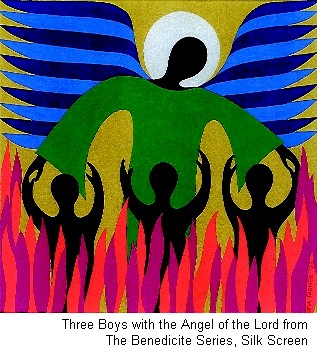 The
Benedicite from the Episcopal Book of Common Prayer of 1928 is an Old Testament
song of creation from the third chapter of the Book of Daniel. It was shouted
out by three young Jewish boys--Shadrach, Meshach and Abednego--from the
midst of a fire into which King Nebuchadnezzar had thrown them. When they
did not burn, but rather sang this magnificent canticle from inside the
flames, the king was moved to accept the sovereignty of their god. The
beauty and strength of each of the symbols mentioned in the Benedicite
speak in a very powerful way. In the summer of 1975, I decided to make
a silk-screen series based upon them, to say in form and color the simplicity
and essence of each. To do this I needed to study ancient manuscript illuminations
to discover how these symbols had been depicted historically. I also needed
to think, to look and to be silent. I stopped my own teaching in order
to take lessons in box-making to protect and house the graphics. Then I
decided to print the canticle using hand-set type rather than calligraphy.
This required studying how to set the Americana font. I wanted the response
"Praise him and magnify him for ever" (Benedicite omnia opera Domini) to
repeat somewhat statically. It was my joy to study privately for two months
with both Lois Stopple (bookbinder and artist from Sonoma County) and Jim
Kohnke (director of the Guild of Book Arts). The graphics are done using
the hand-cut lacquer film method on Swarthmore print paper, cut square
to contain the idea of four-cornered earth and heaven. The whole project
was a shout and a song for me. |

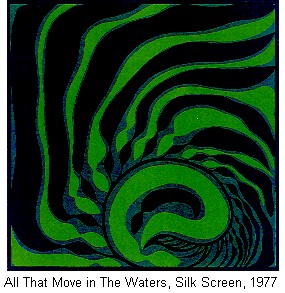
About
ten years ago I was hospitalized with a herniated disk. The pain was incredible;
it affected my sciatic nerve and was also affecting my heart. I was in
ICU for eleven days. At one point the surgeon asked me to stand. The pain
was overwhelming. I didn't know if I was going to live or die. That was
when I came to totally trust God with my life. I had never done that before.
This experience of letting go filled me with a profound peace.
Interestingly, my great-grandfather was a
law partner of Robert Ingersoll, a very famous American atheist. My spiritual
roots may have come through my grandmother and mother, who had a tremendous
love of nature which I also share. My religion is very simple. My
way of accessing spirit is in daily living, and doing simple things, like
walking. I have always walked and hiked. I prefer to be alone when I walk
so I can spend that time in silence. I like to refer to God as our Creator
or O Great Spirit--terms that mean more to me than "father."

In Carmel I had studied a book by Fred Eager on Italic handwriting
and was asked to teach--first some mothers in a parent's group and then
students at All Saints Episcopal Day School. The Reverend Jack Carter,
executive secretary for the National Episcopal  Schools,
put me in charge of handwriting for all the Episcopal schools (more than
a thousand) and sent me to study with Lloyd Reynolds, a renowned teacher
at Reed College in Portland, Oregon. I stayed with Lloyd and his wife for
an entire weekend--which seemed like a lifetime. Lloyd's energy was quite
incredible and he poured himself out, talking to me the whole time I was
there. He ended by appointing me to the Board of the Italic Handwriting
Society of North America and made me one of the competition judges.
Schools,
put me in charge of handwriting for all the Episcopal schools (more than
a thousand) and sent me to study with Lloyd Reynolds, a renowned teacher
at Reed College in Portland, Oregon. I stayed with Lloyd and his wife for
an entire weekend--which seemed like a lifetime. Lloyd's energy was quite
incredible and he poured himself out, talking to me the whole time I was
there. He ended by appointing me to the Board of the Italic Handwriting
Society of North America and made me one of the competition judges.
I visited and stayed with Lloyd several times
over the years but never took formal training with him. However, I did
take a week-long course in calligraphy with Sister Loyola Mary at Maryhurst
College. I did a great deal of commission calligraphic work on the Monterey
Peninsula, and taught in the adult education division in three school districts.
I wrote and published an Italic handwriting textbook to help my students
in 1973. I also was asked to teach handwriting to the headmasters of about
twenty Episcopal schools at a conference in San Antonio, Texas, and wrote
an article about handwriting for the Living Church, the national news-organ
of the Episcopal Church.
I wanted my students to learn
how to write in a beautiful way and to have a sense of beauty about
themselves. I gave them an assignment to write out a response to "Who Am
I?" It wasn't until a student asked me if I had done this exercise myself
that I understood the need for equality between student and teacher. I
had overlooked this, so I decided to write out who I was. This was in 1978.

I started with a list of important symbols: eyes--the light of the spirit
shines through the eyes; hands--that touch and feel and express so much;
ocean; the moon; a crucifix--with opening arms that reveal the center, the
vulnerable heart place; the Carmelite Monastery--south of the town of Carmel;
a place that has been important to me since I was young; and the home in
which we live. My most important word was compassion--meaning with passion
(literally, "to suffer with").
In 1975 I was one of six faculty who formed
the Guild of the Book Arts. We taught a group of eighteen students a variety
of book arts including platen press printing, bookbinding, illumination,
calligraphy, papermaking, paper marbling, silk-screening, and book repair.
We met every day for six weeks. The class was accredited through the San
Jose State extension program. All the students went on to work in various
bookmaking, publishing and related professions.
Teaching is vitally important in order to
stay connected with people, but it means a great tension. Creating art
and teaching require a lot of energy. It is very hard to do both at once.
I came to a rather dramatic stop in my teaching when my therapist thought
it was necessary for me to become more rooted as a person and to accept
myself. At that time I did some deep introverted work and began my Benedicite
series of silkscreens.

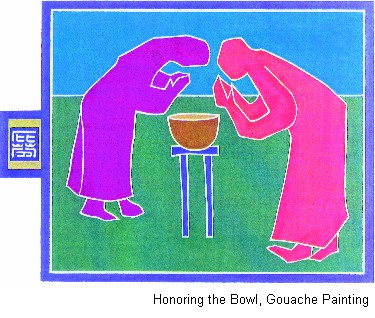 It
may be that the loss of my father and my inability to speak easily has
something to do with my path as an artist. Art has been a healing path
and has also helped me communicate my deep caring for people. In
1979, when asked to speak to Friends of Harrison Memorial Library
in Carmel, I said, "In speaking about creativity and what causes people
to go into art, for me art is an absolute necessity--the need to understand
oneself, and then pay attention to that self." I am an introvert, which
means that I need silence and I need to be alone. I struggle with verbal
expression, yet I need desperately to communicate. Thus color, form, writing,
music and dance must become my means if words are not. The
necessity of art has to do with loving--with understanding
our intimate union with God. It has to do with the gap in human-spiritual
relationships, and our tremendous need for loving intimacy, or union/communion.
Feeling people need focus or they will shatter. Art for me is bringing
order out of chaos--a constant changing of color and form until it is just
right. That rightness is a feeling, an intuition.
It
may be that the loss of my father and my inability to speak easily has
something to do with my path as an artist. Art has been a healing path
and has also helped me communicate my deep caring for people. In
1979, when asked to speak to Friends of Harrison Memorial Library
in Carmel, I said, "In speaking about creativity and what causes people
to go into art, for me art is an absolute necessity--the need to understand
oneself, and then pay attention to that self." I am an introvert, which
means that I need silence and I need to be alone. I struggle with verbal
expression, yet I need desperately to communicate. Thus color, form, writing,
music and dance must become my means if words are not. The
necessity of art has to do with loving--with understanding
our intimate union with God. It has to do with the gap in human-spiritual
relationships, and our tremendous need for loving intimacy, or union/communion.
Feeling people need focus or they will shatter. Art for me is bringing
order out of chaos--a constant changing of color and form until it is just
right. That rightness is a feeling, an intuition.
For me, painting is prayer. Besides making
art, part of creative expression is the importance of sharing it. This
may be with a husband, a child or a beloved friend, or it may be through
an exhibition. Our work must be seen because it is our speech. It is the
point of connection with others.
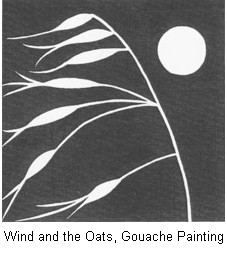
Where does the inspiration for my art come
from? Nature is of primary importance.
There I see the art of our creator--the beauty of clouds, trees and
ocean. I love repeated forms. I found a fern on a hiking trail that was
the exact color and form of seaweed I had seen in a tide pool. People inspire
me--they are God's great works of art. Another source of inspiration
is books. I spent two years in research for my silkscreen of the Phoenix.
Music and sound are other sources. I appreciate the order that comes out
of chaos in the music of Bach, Vivaldi, Telemann and Mozart.
 One of the students at Pendle Hill led an afternoon
session by asking our class to go outside--to stand in absolute silence
and to listen to every sound we could hear--and to pretend that we were
scoring a symphony. A train going by went into the bass clef; the birds
singing were the soprano line, the melody, the snow falling, the leaves
crunching under foot--every sound combined into a perfectly beautiful symphony.
Through my life, I have always sought quiet. My husband and I are very
quiet in our living--we read, write, cook, walk and enjoy the peace of the
wonderful silence.
One of the students at Pendle Hill led an afternoon
session by asking our class to go outside--to stand in absolute silence
and to listen to every sound we could hear--and to pretend that we were
scoring a symphony. A train going by went into the bass clef; the birds
singing were the soprano line, the melody, the snow falling, the leaves
crunching under foot--every sound combined into a perfectly beautiful symphony.
Through my life, I have always sought quiet. My husband and I are very
quiet in our living--we read, write, cook, walk and enjoy the peace of the
wonderful silence.
It is important for me to live and to make
things as simple as possible. I want my art to be simple and universal.
That means that I often do not put faces on figures. My recent paintings
based on photos I took of totem figures in Alaska show my fascination with
color and form. I am working with bits and pieces of these images, mostly
only changing the colors. The cover image is part of a raven totem. I did
change this piece quite a bit from the original. The eye has to do with
the inner being--the light of the soul.
None of my work is on the walls in our home.
When I finish a piece, I don't need it anymore. It was wonderful to make,
but when I am finished I need to go ahead to the next piece--constantly
going forward. My art draws me more deeply into the spiritual. When I look
back, I may see that it was far ahead of my spiritual understanding at
the time. Sometimes other people see things that I don't--things that I
need to think about. That is exciting.


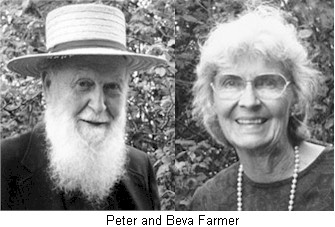
 About
ten years ago I was hospitalized with a herniated disk. The pain was incredible;
it affected my sciatic nerve and was also affecting my heart. I was in
ICU for eleven days. At one point the surgeon asked me to stand. The pain
was overwhelming. I didn't know if I was going to live or die. That was
when I came to totally trust God with my life. I had never done that before.
This experience of letting go filled me with a profound peace.
About
ten years ago I was hospitalized with a herniated disk. The pain was incredible;
it affected my sciatic nerve and was also affecting my heart. I was in
ICU for eleven days. At one point the surgeon asked me to stand. The pain
was overwhelming. I didn't know if I was going to live or die. That was
when I came to totally trust God with my life. I had never done that before.
This experience of letting go filled me with a profound peace.